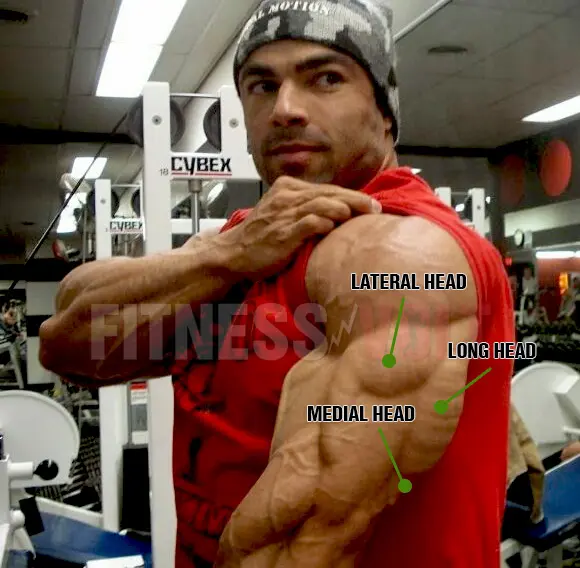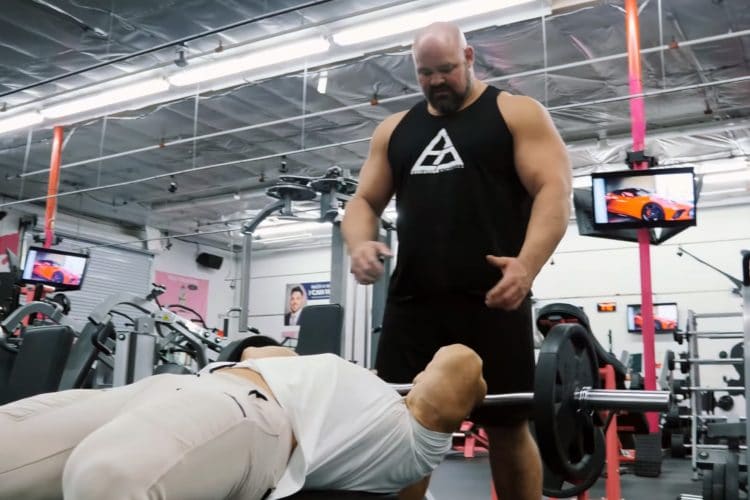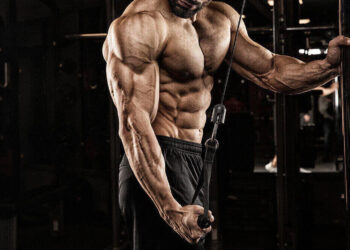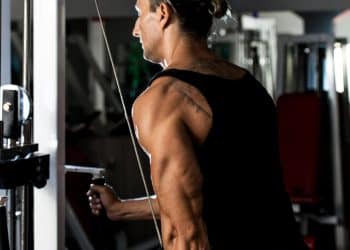To the uninitiated, supine triceps extensions and skull crushers are the same thing. And, in truth, while there ARE some subtle differences, these two movements are largely interchangeable.
That said, because there are some differences, each one will affect your muscles slightly differently, so it pays to choose the one that provides the most benefits for the least amount of risk.
One way to determine the effectiveness of two different exercises is to do each one for a couple of months each and then see which one produced the best results. While such an experiment can be helpful for judging the effectiveness of an exercise, it’s also time-consuming.
So, to save from having to do a prolonged experiment, in this guide, we compare and contrast triceps extensions with skull crushers so you can choose the one that’s right for you.
Supine Triceps Extensions 101
The supine triceps extension is an isolation exercise for the triceps brachii, which is the muscle on the back of your upper arm. Somewhat confusingly, this exercise can also be done seated or standing – the overhead triceps extension.
The main thing to note with both of these exercises is that the bar is lowered BEHIND the head when you do it. This takes the elbow through a large range of motion and provides the triceps with a nice stretch at the midpoint of each rep.
Level Up Your Fitness: Join our 💪 strong community in Fitness Volt Newsletter. Get daily inspiration, expert-backed workouts, nutrition tips, the latest in strength sports, and the support you need to reach your goals. Subscribe for free!
However, this range of motion requires good mobility and flexibility. For example, tight muscles and joints make triceps extensions, especially the overhead variation, very difficult to do correctly.
Muscles Worked
The triceps extension is an isolation exercise which means it involves movement at just one joint – the elbow. While it trains several important upper body muscles, the triceps brachii do most of the work.
Triceps brachii, usually just called the triceps for short, is the large muscle located on the back of your upper arm. The triceps are a three-headed arm muscle with three origin sites and one insertion. Its functions are elbow and shoulder extension.

The triceps has three heads:
While all three heads are involved in triceps extensions, the long head is the most active during this exercise. The long head crosses the elbow AND the shoulder, and the angle of your arm during triceps extensions means that this muscle works a little harder than the other two heads.
How to do Triceps Extensions
Get the most from triceps extensions by doing it correctly. Here are step-by-step instructions for supine AND seated/standing triceps extensions.
For supine triceps extension:
- Sit on an exercise bench with a barbell or EZ bar resting on your thighs. Hold the bar with an overhand, slightly narrower than shoulder-width grip.
- Lie back and lift the bar so your arms are straight and the weight is above your chest.
- Next, let your arms drift backward so the bar is over your face and your arms are slightly angled.
- Keeping your arms in this position, bend your elbows and lower the bar down to the top of your head. Use as large a range of motion as you safely and comfortably can; get a good stretch in your triceps.
- Extend your arms and repeat.
- You can also do this exercise with dumbbells or using a cable machine.
For seated/standing triceps extension:
- Sit or stand so your torso is upright. Hold an EZ bar or barbell with a slightly narrower than shoulder-width overhand grip.
- Press the bar up and over your head, so your biceps are next to your ears.
- Without moving your upper arms, bend your elbows and lower the weight down behind your head.
- Extend your elbows and return to the starting position.
Triceps Extension Pros & Cons
Pros
Not sure if supine or upright triceps extensions are the right exercise for you? Consider these pros and then decide:
- A large range of motion – exercises with a large ROM are good for triggering hypertrophy. Moving the weight further means more work per rep, which can translate to more significant muscle growth and better gains.
- Constant triceps tension – angling your arms slightly backward means your muscles are under constant tension, even between reps. This should mean a better pump and plenty of stimulus for growth.
- A better workout with less weight – a bigger ROM and constant tension mean that you won’t need to use huge weights to overload your triceps. Compared to some other triceps exercises, triceps extensions are relatively joint-friendly.
- Do them supine or upright – seated or standing triceps extensions, also known as French presses, are a valuable alternative to the supine version. However, doing the same exercises all the time can soon get old. Having more exercises to choose from means your workouts need never be boring or unproductive.
- Good for supersets – finish your set of triceps extensions with some close-grip bench presses to really fry your arms and get an even better pump. One exercise flows perfectly into the next. This sequence is a form of pre-exhaust training.
Cons
While triceps extensions are a largely safe and effective exercise, there are a couple of drawbacks to consider:
- Elbow pain – supine and upright triceps extensions put your elbows in an awkward position, which could lead to joint stress and elbow pain. As such, it’s important not to go too heavy too soon with either variation.
- Risk of injury – while the triceps extension is a relatively safe exercise, there is still a risk of hitting yourself in the head with a barbell if you fail mid-rep. As such, this exercise is best done with a spotter on hand. If you train alone, stop your set 1-2 reps shy of failure.
- Requires good mobility and flexibility – seated and standing triceps extensions require good shoulder mobility. If you have tight or painful shoulders, you may be unable to lower the bar down behind your head and will have to stick with the more forgiving supine variation.
Skull Crusher 101
Skull crushers are very similar to supine triceps extensions. The main differences are the range of motion, angle of your upper arms, and travel path of the bar. With skull crushers, you lower the barbell to your forehead, which is where this exercise gets its name. Lower the bar too fast, and you could end up hitting yourself in the head!
Level Up Your Fitness: Join our 💪 strong community in Fitness Volt Newsletter. Get daily inspiration, expert-backed workouts, nutrition tips, the latest in strength sports, and the support you need to reach your goals. Subscribe for free!

Muscles Worked
Skull crushers involve the same muscles as triceps extensions. However, the angle of the upper arms is different, and the range of motion is slightly shorter, so the long head of the triceps doesn’t have quite as much work to do.
How to do Skull Crushers
Get the most from skull crushers by doing them correctly:
- Sit on an exercise bench with a barbell or EZ bar resting on your thighs. Hold the bar with an overhand, slightly narrower than shoulder-width grip.
- Lie back and simultaneously lift the bar, so your arms are straight and vertical, and the weight is above your chest.
- Without moving your upper arms, bend your elbows and lower the weight down toward your forehead. Your upper arms should remain vertical throughout.
- Take care to lower the bar slowly to avoid hitting yourself on the head.
- Extend your arms and repeat.
- This exercise can also be done using dumbbells or a cable machine.
Related: Standing Skull Crushers
Skull Crusher Pros & Cons
Pros
Not sure if skull crushers are the right triceps exercise for you? Consider these benefits and then decide:
- An effective way to isolate your triceps – skull crushers are an excellent triceps exercise. Whether you want to increase muscle size, strength, or endurance, skull crushers can help.
- More forgiving than triceps extensions – with their shorter range of motion, triceps extensions are marginally easier than supine and overhead triceps extensions and maybe better for beginner exercisers.
- Good for supersets – like triceps extensions, skull crushers also work really well with close-grip bench presses for pre-exhaust supersets.
Cons
While skull crushers are a safe and beneficial triceps exercise, there are a couple of drawbacks to consider:
- Not much muscle tension at the top of each rep – muscle tension tends to drop off quite significantly as you lock out your elbows between reps. This means that skull crushers are potentially a little less efficient than supine triceps extensions.
- Significant risk of injury – purposely lowering a loaded barbell to your forehead makes this exercise pretty risky. Plenty of lifters have been struck in the head with a weight after training to failure without a spotter. For safety, you should always do this exercise with someone nearby to help you if you get into difficulties.
Triceps Extensions vs. Skull Crushers – Which is Best?
As you now know, there really isn’t much difference between triceps extensions and skull crushers. They both isolate your triceps very effectively and can help you build bigger, stronger elbow extensors.
Combined with exercises like dips, close grip bench presses, and triceps pushdowns, both triceps extensions and skull crushers can help you build the upper arms of your dreams.
But which one is best?
The truth is that’s an impossible question to answer. It’s like asking whether barbell curls are better than dumbbell curls or front squats are better than back squats. Both triceps extensions and skull crushers can help you to build muscle and sculpt the arms big, strong arms.
So, do the version you prefer, or if you can’t choose, alternate between them and enjoy all the benefits both of these exercises have to offer. Or do neither and do a completely different triceps exercise, like triceps kickbacks!
Ultimately, triceps extensions and skull crushers are completely interchangeable. The right one for you is the one you enjoy the most and that produces the best results. In this exercise match-up, there is no clear winner – sorry!
Related: The Best Triceps Exercises According to Science
Wrapping Up
Triceps Extensions Vs. Skull Crushers – Fitness experts love to promote their favorite exercises, saying that such-and-such an exercise is best and that everyone should do it. However, points of view like this fail to acknowledge that everyone is different.
Things like limb length, muscle attachment sites, and muscle belly length mean that the best exercise for one person may be utterly unproductive for someone else.
The good news is that there are hundreds if not thousands of exercises to choose from, and, among them, you should be able to find the exercises that are most productive for you.
Finding the best approach to training will take some time and will probably change as you progress from beginner to intermediate and advanced lifter. But that’s all part of the journey.
So, rather than try and make a square peg fit into a round hole by using someone else’s best exercises, try a variety of movements and find what works best for YOU. That’s how you make your workouts as productive as possible!








